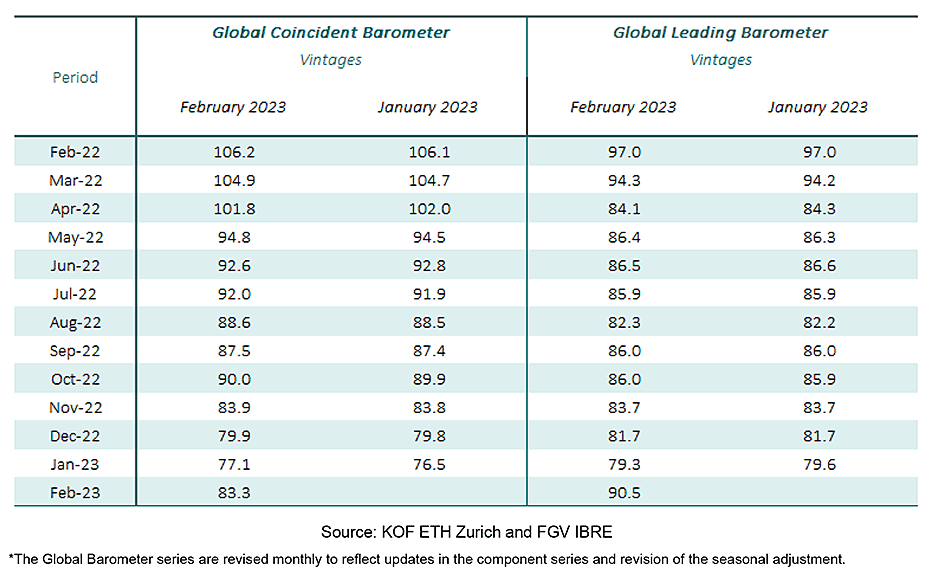Global Barometers show upward corrections
The Global Barometers increase in February for the first time since November 2022 across all regions, with the Asia, Pacific & Africa region standing out for the improved climate in the region.

In February 2023, the Coincident Global Economic Barometer rises 6.2 points to 83.3 points. The Leading Global Economic Barometer increases 11.2 points to 90.5 points, the highest level since March 2022. With this result, the Coincident Barometer recovers almost 50% of the loses recorded in the previous three months, while the Leading Barometer recovers more than 100% of the loses in the same period. The increase in both indicators is to a large extent driven by the Asia, Pacific & Africa region.
“In recent months, the Asia, Pacific and Africa region has been a major driver of the global economic barometers. This time it is the end of the zero-covid policy in China that is improving sentiment across the region. At least from this perspective, the rollercoaster ride of economic sentiment regarding the Chinese economy may be coming to an end. Together with a milder than feared winter in Europe and a generally quite robust US economy, a somewhat more positive tone is now being struck for the coming months than at the beginning of the year. Nevertheless, the barometer readings are still far below their long-term averages, indicating that momentum remains weak”, evaluates Jan-Egbert Sturm, Director at KOF Swiss Economic Institute.
“The rollercoaster ride of economic sentiment regarding the Chinese economy might come to an end. This, the milder winter in Europe and a quite robust US economy, a somewhat more positive tone is now being struck for the coming months. Nevertheless, the barometer readings are still far below their long-term averages, indicating that momentum remains weak.”Jan-Egbert Sturm
Coincident Barometer – regions and sectors
In February, the Asia, Pacific & Africa region contributes 5.0 points to the 6.2-point increase in the Coincident indicator, the Western Hemisphere 0.8 points, and Europe 0.5 points. The rise in the regional indicator for the Asia, Pacific & Africa region reflects the reopening of the Chinese economy, with the end of the Covid zero policy, and the impact of this opening in other countries in the region. The graph below illustrates the contribution of each region to the deviation of the Coincident Barometer from the historical mean of 100 points.
All the coincident sector indicators increase in February 2023, which has not happened since March of 2021. The Services sector records the highest level among the sectors for the third month in a row.
Leading Barometer – regions and sectors
The Leading Global Barometer leads the world economic growth rate cycle by three to six months on average. The Asia, Pacific & Africa region contributes 8.6 points to the 11.2-point rise in the indicator in February after four months of heading in the opposite direction. Europe and the Western Hemisphere also contribute positively, but to a lesser extent, with 1.7 and 0.8 points, respectively.
All the Leading indicator sectors increase in February, with Industry standing out with a rise of almost 14 points for the month. As in the case of the Coincident indicator, Construction has the lowest level among the sectors, reflecting a pessimistic outlook for the coming months.
The Global Economic Barometers
The Global Economic Barometers are a system of indicators enabling timely analysis of global economic development. They represent a collaboration between the KOF Swiss Economic Institute of the ETH Zurich in Switzerland and Fundação Getulio Vargas (FGV), based in Rio de Janeiro, Brazil. The system consists of two composite indicators, the Coincident Barometer and the Leading Barometer. The Coincident Barometer reflects the current state of economic activity, while the Leading Barometer provides a cyclical signal roughly six months ahead of current economic developments.
The two Barometers comprise the results of economic tendency surveys conducted in more than 50 countries with the aim of achieving the broadest possible global coverage. The advantages of economic tendency surveys are that their results are usually readily available and are not substantially revised after first publication.
The Coincident Barometer includes more than 1,000 different time series, while the Leading Barometer consists of over 600 time series. Cross-correlation analysis is used to decide which individual time series are included in the barometers. This involves correlating the individual time series with a reference series. The reference series used is the year-on-year growth rate of global gross domestic product (GDP), where the individual national GDPs are aggregated at purchasing power parity to form global GDP. A time series is only included in a Barometer if it shows a sufficiently high correlation and a suitable synchronization or lead with the reference series. The time period used for this correlation analysis currently runs from January 2010 to December 2019.
The series of the two Barometers are revised each month at publication and are standardized to have a mean of 100 and a standard deviation of 10 for the 10-year period previous to the most recent observations.
The methodology is described in:
Klaus Abberger, Michael Graff, Aloisio Jr. Campelo, Anna Carolina Lemos Gouveia, Oliver Müller and Jan-Egbert Sturm (2020), The Global Economic Barometers: Composite indicators for the world economy. KOF Working Papers, vol. 471, Zurich: KOF Swiss Economic Institute, ETH Zurich, 2020.
Contact
KOF Konjunkturforschungsstelle
Leonhardstrasse 21
8092
Zürich
Switzerland

